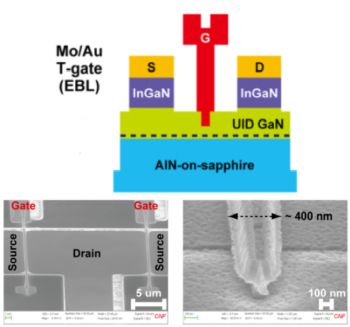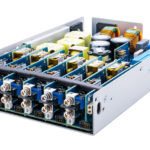Researchers at Cornell University and Intel Corp. say they’ve devices a wide-bandgap p-type
transistor counterpart of the n-channel GaN HFET. In a paper to be presented at the upcoming IEDM conference (Paper #8.3, “GaN/AlN p-Channel HFETs with I max >420 mA/mm and ~20
GHz f T /f MAX ,” K. Nomoto et al, Cornell University/Intel), the group says it was able to synthesize p-channel transistor on-currents of 428 mA/mm with cutoff frequencies in the 20 GHz regime.
A p-channel version of the n-channel GaN HFET holds much promise for several novel applications ranging from active loads for wide-bandwidth amplifiers, to power DACs and digital power amplifiers to ease impedance matching and power combining.
What makes this development possible is the recent discovery of a very high-density polarization-induced 2D hole gas (2DHG, basically a gas constrained to move only in two dimensions) at the interface between the GaN semiconductor material and the AlN layer upon which the GaN is deposited. Using this material, it’s possible to devise low-resistance ohmic contacts that enable the construction of Schottky-gate p-channel GaN HFETs that reach on currents exceeding 420 mA/mm and fT/fMAX ~20 GHz.

The nitride p-channel HFET build process starts with growing GaN/AlN epitaxial layers using plasma-assisted molecular beam epitaxy (MBE) on Al-polar AlN/Sapphire templates. The epitaxial stack consists of a ~500 nm AlN buffer, a ~15 nm undoped GaN layer, and a ~15 nm heavily Mg-doped ~5% InGaN layer. The high-density 2DHG arises from a polarization-discontinuity at the GaN/AlN interface, and is quantum-confined in the GaN layer. The InGaN layer primarily makes possible low-resistance ohmic contacts, with the secondary benefit of enhancing the polarization-induced 2DHG. The mechanism of formation of the 2DHG is the valence-band analog of what enables the 2DEG in n-channel III-nitride HFETs.
All in all, researchers say the p-channel GaN HFET performs 4× better than the last generation and marks the first nitride p-channel transistor that breaks the GHz speed barrier. The increased drive current and speed of the p-HFETs in the AlN/GaN platform, combined with the excellent performance of the n-HFETs on the same platform, is expected to take this wide-bandgap CMOS platform into new application domains in the RF and power electronics arenas
The 66th annual edition of the IEEE International Electron Devices Meeting (IEDM), the world’s premier forum for the presentation of applied research in transistors and related devices, will take place virtually this year. The conference will now run from Saturday through Friday, December 12-18, 2020, and will offer a mix of live-streamed events and on-demand pre-recorded presentations, with a schedule of live Q&A sessions. The expanded schedule is intended to give global attendees enough time to review the more than 220 papers in the IEDM technical program, plus the tutorials and short courses, and to participate in the live-streamed events, such as the plenary presentations, panel discussion and career session.
This year’s theme is “Innovative Devices for a Better Future,” which reflects the fact that, at a time of great global uncertainty, electronics technology is being used much more broadly than ever before to address the world’s most pressing challenges.
“This year’s format may be different, but what hasn’t changed at all is that IEDM will once again offer an outstanding technical program that showcases important breakthroughs in key semiconductor and related technologies, which are essential for the progress of modern society,” said Dina Triyoso, IEDM 2020 Publicity Chair and Technologist at TEL Technology Center, America, LLC. “I’m very proud of the fact that, despite the laboratory restrictions and all of the other challenges imposed on us by the pandemic, our community has persevered and driven the state-of-the-art of electronics technology forward yet again.”
“Although a virtual experience doesn’t give us the ability to see our colleagues in person, it does provide unique opportunities which we have tried to maximize,” said Meng-Fan (Marvin) Chang, IEDM 2020 Publicity Vice Chair, IEEE Fellow, Distinguished Professor of Electrical Engineering at National Tsing Hua University and Director of Corporate Research at TSMC. “For example, if IEDM were a physical event this year, nine technical sessions would run in parallel. An attendee likely would find it difficult to attend all talks of interest. But with recorded presentations available on-demand a week ahead of time, that roadblock is eliminated.”







Leave a Reply